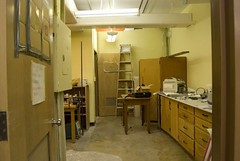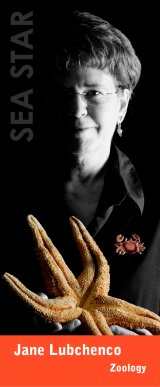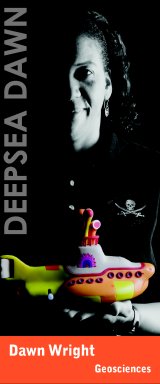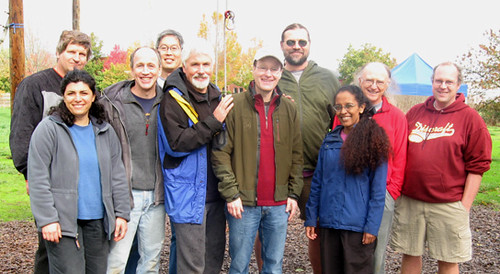Seen around campus
January 17th, 2008Revealing how life works at the molecular level
January 17th, 2008The Department of Biochemistry and Biophysics faculty (BB is fun!)
Below, Dr. Andy Karplus, new department chair.
Here are a few thoughts from Andy on the department, whose mission is Revealing How Life Works at the Molecular Level:
 My name is Andy Karplus and my research specialty is protein crystallography—figuring out the three-dimensional structure of proteins and from those structures deciphering how they carry out their specific functions. My current projects include work on the enzyme causing Amyotrophic Lateral Sclerosis (Lou Gehrig’s Disease) and pursuing our “floodgate” hypothesis describing how one enzyme family helps regulate cell growth and development through controlling intracellular hydrogen peroxide levels. I received my PhD at the University of Washington in 1984, completed a four-year postdoc in Freiburg, Germany, and then was on the faculty at Cornell University for ten years before choosing to move my program to Oregon State in 1998.
My name is Andy Karplus and my research specialty is protein crystallography—figuring out the three-dimensional structure of proteins and from those structures deciphering how they carry out their specific functions. My current projects include work on the enzyme causing Amyotrophic Lateral Sclerosis (Lou Gehrig’s Disease) and pursuing our “floodgate” hypothesis describing how one enzyme family helps regulate cell growth and development through controlling intracellular hydrogen peroxide levels. I received my PhD at the University of Washington in 1984, completed a four-year postdoc in Freiburg, Germany, and then was on the faculty at Cornell University for ten years before choosing to move my program to Oregon State in 1998.
The Department attracted me from Cornell in 1998, and from where I sit as the new chair, I can tell you this is an amazing time and place. As research into the molecular aspects of life becomes increasingly important to breakthroughs in human health, agriculture, environmental sciences, and even engineering and nanotechnology, so does the mission of our department. Our two-fold goals of educating students and carrying out forefront research in Biochemistry and Biophysics have never been more important to the success of Oregon, the nation, and the world.
Our students give friends and alumni much to be proud of:
-
Students in the Biochemistry and Biophysics (BB) major at OSU pursue one of the most challenging scientific programs in the College of Science. Spanning both the physical sciences (chemistry and physics) and the biological sciences (biology, genetics, and microbiology), the program provides our students with broad and yet rigorous training for careers in biomedicine.
-
As the number of students at OSU has grown from about 14,000 students to 18,000 in the past ten years, the number of BB majors has grown even faster, nearly doubling from about 70 majors to approximately 130 today.
-
BB majors are campus leaders and represent the best and brightest students in the state of Oregon. They enter OSU with average SAT scores that are 160 points above the University average, and compete with the very best in the nation.
-
From the years 2004-2006, five of the six Goldwater scholars in the entire Oregon University System were BB majors from OSU.
-
BB majors have also performed superbly in achieving their career goals. Each year, at least 50% graduate with the distinction of cum laude or higher, and of the last 37 BB majors to apply to medical school, 35 have been accepted, with the other two still in the application process.
-
In addition to the training of our BB majors, we educate over 1000 students per year in general biochemistry.
In other highlights, BB faculty maintain active research programs that brought in $2.5 million in external funding last year. Areas of focus include revealing the mechanisms that allow cells to move during wound healing, the relationships between oxidative stress and cancer, the structure and function of a motor protein that is required for cell division and development, the regulation of the production of the building blocks of DNA, and the biochemistry of chromatophores and camouflage. Our newest assistant professor, Michael Freitag, is revealing how chromosomes are recognized for proper cell division, and our research program has been greatly strengthened through the addition of Linus Pauling Institute faculty Balz Frei, Tory Hagen, and Joe Beckman with research programs focussing on micronutrients and health, aging, and neurodegenerative disease. Having faculty doing cutting-edge research and a vibrant PhD program strengthens our undergraduate program both because faculty are not just teaching from the textbooks but from the current advances, and because our undergraduates then can personally participate in research as part of their training.
Breaking the Tyranny of the Textbook
January 14th, 2008

Here is the rabbit-warren to be renovated in Weniger Hall…and the cutting-edge classroom that will be created to carry out the “Paradigms In Physics” program for first-and second-year students in Physics at OSU.
The experience of being an upper-level undergraduate student in Physics at OSU has been transformed through a re-envisioning of the learning process. Our program, “Paradigms in Physics”, is funded by the National Science Foundation and is the first curriculum of its type in the country.
For example, they can start directly from physical observations and experimentation with equipment, move to problem solving for that situation, and then explore more difficult extensions through computer simulations. Students can work at a more flexible pace, and use interactions with each other and the instructors as ways to test and explore their own understanding. In dedicated, modernized classrooms with high-tech teaching aids, students will sit at modular tables with three students to a group. Students can face forward when information needs to be delivered to the class as a whole, but a quick move of chairs will transform the class into working groups. Each group will have a tablet PC for problem-solving, access to small equipment modules for testing ideas, and a white-board and a smart-board for brainstorming. Information will be uploaded to the instructor’s computer for real-time feedback on problem-solving. The group members will discuss amongst themselves, create models, physically test predictions based on their models, and present solutions to the entire class.
This active learning style has been proven to change thought patterns, excite strong students, and provide support for weaker students.
—-
We’re working on funding the $500,000 budget for this project via private support–we’re about $200k toward that goal so far.
$77M for new Science Center
January 10th, 2008 Oregon State University has received $77 million in private and public commitments to construct the Linus Pauling Science Center and provide support for associated research and education programs.
Oregon State University has received $77 million in private and public commitments to construct the Linus Pauling Science Center and provide support for associated research and education programs.
The new facility, named for Linus Pauling, a 1922 OSU graduate and the only person to win two unshared Nobel Prizes, will house the Linus Pauling Institute and chemists from the College of Science. The facility will also contain classroom and laboratory space for undergraduates, graduate students, and researchers studying chemistry, biology, and life sciences.
”This investment will have a transformational impact on the sciences at Oregon State University,” said President Ed Ray. “It will advance health care research, spur the development of new discoveries and programs that will bolster our economy, and help educate the next generation of scientists, who will define the future of health care.”
Funding for the $62.5 million state-of-the-art building includes a $20 million commitment from the Wayne and Gladys Valley Foundation of Oakland, Calif., which was matched by gifts from other donors. These private commitments helped the university secure another $31.25 million in state bonds.
The Valley Foundation has also challenged OSU to raise at least $15 million in additional support for science research and education programs, including faculty positions and scholarships. To date more than $14 million has been committed from nearly 750 donors.
Approximately 120,000 square feet, the Linus Pauling Science Center will occupy the corner of Campus Way and 30th Street, next to existing science facilities.
—–
We are working with donors to offer naming opportunities in the new building for gifts designated for chemistry and life sciences. Naming can be acquired for a gift of $10,000 or more.






